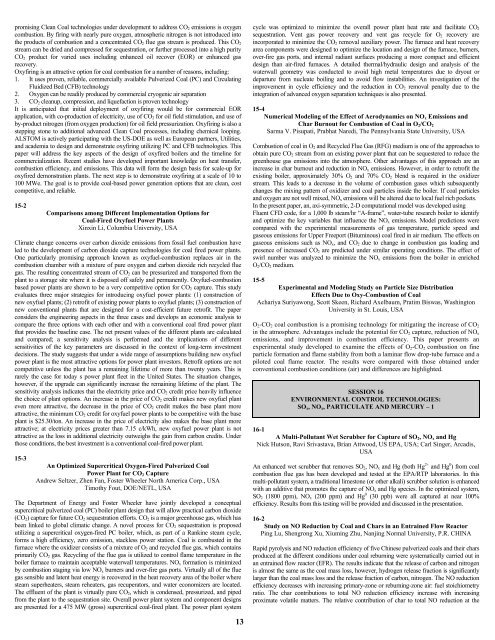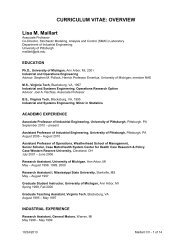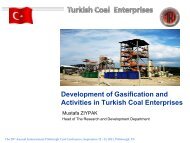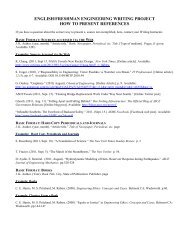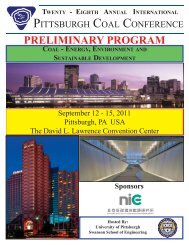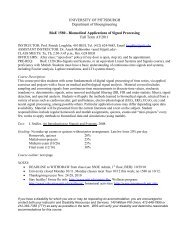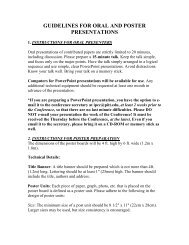Abstract Booklet 2006 - Swanson School of Engineering - University ...
Abstract Booklet 2006 - Swanson School of Engineering - University ...
Abstract Booklet 2006 - Swanson School of Engineering - University ...
You also want an ePaper? Increase the reach of your titles
YUMPU automatically turns print PDFs into web optimized ePapers that Google loves.
promising Clean Coal technologies under development to address CO 2 emissions is oxygen<br />
combustion. By firing with nearly pure oxygen, atmospheric nitrogen is not introduced into<br />
the products <strong>of</strong> combustion and a concentrated CO 2 flue gas stream is produced. This CO 2<br />
stream can be dried and compressed for sequestration, or further processed into a high purity<br />
CO 2 product for varied uses including enhanced oil recover (EOR) or enhanced gas<br />
recovery.<br />
Oxyfiring is an attractive option for coal combustion for a number <strong>of</strong> reasons, including:<br />
1. It uses proven, reliable, commercially available Pulverized Coal (PC) and Circulating<br />
Fluidized Bed (CFB) technology<br />
2. Oxygen can be readily produced by commercial cryogenic air separation<br />
3. CO 2 cleanup, compression, and liquefaction is proven technology<br />
It is anticipated that initial deployment <strong>of</strong> oxyfiring would be for commercial EOR<br />
application, with co-production <strong>of</strong> electricity, use <strong>of</strong> CO 2 for oil field stimulation, and use <strong>of</strong><br />
by-product nitrogen (from oxygen production) for oil field pressurization. Oxyfiring is also a<br />
stepping stone to additional advanced Clean Coal processes, including chemical looping.<br />
ALSTOM is actively participating with the US-DOE as well as European partners, Utilities,<br />
and academia to design and demonstrate oxyfiring utilizing PC and CFB technologies. This<br />
paper will address the key aspects <strong>of</strong> the design <strong>of</strong> oxyfired boilers and the timeline for<br />
commercialization. Recent studies have developed important knowledge on heat transfer,<br />
combustion efficiency, and emissions. This data will form the design basis for scale-up for<br />
oxyfired demonstration plants. The next step is to demonstrate oxyfiring at a scale <strong>of</strong> 10 to<br />
100 MWe. The goal is to provide coal-based power generation options that are clean, cost<br />
competitive, and reliable.<br />
15-2<br />
Comparisons among Different Implementation Options for<br />
Coal-Fired Oxyfuel Power Plants<br />
Xinxin Li, Columbia <strong>University</strong>, USA<br />
Climate change concerns over carbon dioxide emissions from fossil fuel combustion have<br />
led to the development <strong>of</strong> carbon dioxide capture technologies for coal fired power plants.<br />
One particularly promising approach known as oxyfuel-combustion replaces air in the<br />
combustion chamber with a mixture <strong>of</strong> pure oxygen and carbon dioxide rich recycled flue<br />
gas. The resulting concentrated stream <strong>of</strong> CO 2 can be pressurized and transported from the<br />
plant to a storage site where it is disposed <strong>of</strong>f safely and permanently. Oxyfuel-combustion<br />
based power plants are shown to be a very competitive option for CO 2 capture. This study<br />
evaluates three major strategies for introducing oxyfuel power plants: (1) construction <strong>of</strong><br />
new oxyfuel plants; (2) retr<strong>of</strong>it <strong>of</strong> existing power plants to oxyfuel plants; (3) construction <strong>of</strong><br />
new conventional plants that are designed for a cost-efficient future retr<strong>of</strong>it. The paper<br />
considers the engineering aspects in the three cases and develops an economic analysis to<br />
compare the three options with each other and with a conventional coal fired power plant<br />
that provides the baseline case. The net present values <strong>of</strong> the different plants are calculated<br />
and compared; a sensitivity analysis is performed and the implications <strong>of</strong> different<br />
sensitivities <strong>of</strong> the key parameters are discussed in the context <strong>of</strong> long-term investment<br />
decisions. The study suggests that under a wide range <strong>of</strong> assumptions building new oxyfuel<br />
power plant is the most attractive options for power plant investors. Retr<strong>of</strong>it options are not<br />
competitive unless the plant has a remaining lifetime <strong>of</strong> more than twenty years. This is<br />
rarely the case for today s power plant fleet in the United States. The situation changes,<br />
however, if the upgrade can significantly increase the remaining lifetime <strong>of</strong> the plant. The<br />
sensitivity analysis indicates that the electricity price and CO 2 credit price heavily influence<br />
the choice <strong>of</strong> plant options. An increase in the price <strong>of</strong> CO 2 credit makes new oxyfuel plant<br />
even more attractive, the decrease in the price <strong>of</strong> CO 2 credit makes the base plant more<br />
attractive, the minimum CO 2 credit for oxyfuel power plants to be competitive with the base<br />
plant is $25.30/ton. An increase in the price <strong>of</strong> electricity also makes the base plant more<br />
attractive; at electricity prices greater than 7.15 c/kWh, new oxyfuel power plant is not<br />
attractive as the loss in additional electricity outweighs the gain from carbon credits. Under<br />
those conditions, the best investment is a conventional coal-fired power plant.<br />
15-3<br />
An Optimized Supercritical Oxygen-Fired Pulverized Coal<br />
Power Plant for CO 2 Capture<br />
Andrew Seltzer, Zhen Fan, Foster Wheeler North America Corp., USA<br />
Timothy Fout, DOE/NETL, USA<br />
The Department <strong>of</strong> Energy and Foster Wheeler have jointly developed a conceptual<br />
supercritical pulverized coal (PC) boiler plant design that will allow practical carbon dioxide<br />
(CO 2 ) capture for future CO 2 sequestration efforts. CO 2 is a major greenhouse gas, which has<br />
been linked to global climatic change. A novel process for CO 2 sequestration is proposed<br />
utilizing a supercritical oxygen-fired PC boiler, which, as part <strong>of</strong> a Rankine steam cycle,<br />
forms a high efficiency, zero emission, stackless power station. Coal is combusted in the<br />
furnace where the oxidizer consists <strong>of</strong> a mixture <strong>of</strong> O 2 and recycled flue gas, which contains<br />
primarily CO 2 gas. Recycling <strong>of</strong> the flue gas is utilized to control flame temperature in the<br />
boiler furnace to maintain acceptable waterwall temperatures. NO x formation is minimized<br />
by combustion staging via low NO x burners and over-fire gas ports. Virtually all <strong>of</strong> the flue<br />
gas sensible and latent heat energy is recovered in the heat recovery area <strong>of</strong> the boiler where<br />
steam superheaters, steam reheaters, gas recuperators, and water economizers are located.<br />
The effluent <strong>of</strong> the plant is virtually pure CO 2 , which is condensed, pressurized, and piped<br />
from the plant to the sequestration site. Overall power plant system and component designs<br />
are presented for a 475 MW (gross) supercritical coal-fired plant. The power plant system<br />
cycle was optimized to minimize the overall power plant heat rate and facilitate CO 2<br />
sequestration. Vent gas power recovery and vent gas recycle for O 2 recovery are<br />
incorporated to minimize the CO 2 removal auxiliary power. The furnace and heat recovery<br />
area components were designed to optimize the location and design <strong>of</strong> the furnace, burners,<br />
over-fire gas ports, and internal radiant surfaces producing a more compact and efficient<br />
design than air-fired furnaces. A detailed thermal/hydraulic design and analysis <strong>of</strong> the<br />
waterwall geometry was conducted to avoid high metal temperatures due to dryout or<br />
departure from nucleate boiling and to avoid flow instabilities. An investigation <strong>of</strong> the<br />
improvement in cycle efficiency and the reduction in CO 2 removal penalty due to the<br />
integration <strong>of</strong> advanced oxygen separation techniques is also presented.<br />
15-4<br />
Numerical Modeling <strong>of</strong> the Effect <strong>of</strong> Aerodynamics on NO x Emissions and<br />
Char Burnout for Combustion <strong>of</strong> Coal in O 2 /CO 2<br />
Sarma V. Pisupati, Prabhat Naredi, The Pennsylvania State <strong>University</strong>, USA<br />
Combustion <strong>of</strong> coal in O 2 and Recycled Flue Gas (RFG) medium is one <strong>of</strong> the approaches to<br />
obtain pure CO 2 stream from an existing power plant that can be sequestered to reduce the<br />
greenhouse gas emissions into the atmosphere. Other advantages <strong>of</strong> this approach are an<br />
increase in char burnout and reduction in NO x emissions. However, in order to retr<strong>of</strong>it the<br />
existing boiler, approximately 30% O 2 and 70% CO 2 blend is required in the oxidizer<br />
stream. This leads to a decrease in the volume <strong>of</strong> combustion gases which subsequently<br />
changes the mixing pattern <strong>of</strong> oxidizer and coal particles inside the boiler. If coal particles<br />
and oxygen are not well mixed, NO x emissions will be altered due to local fuel rich pockets.<br />
In the present paper, an, axi-symmetric, 2-D computational model was developed using<br />
Fluent CFD code, for a 1,000 lb steam/hr “A-frame”, water-tube research boiler to identify<br />
and optimize the key variables that influence the NO x emissions. Model predictions were<br />
compared with the experimental measurements <strong>of</strong> gas temperature, particle speed and<br />
gaseous emissions for Upper Freeport (Bituminous) coal fired in air medium. The effects on<br />
gaseous emissions such as NO x , and CO 2 due to change in combustion gas loading and<br />
presence <strong>of</strong> increased CO 2 are predicted under similar operating conditions. The effect <strong>of</strong><br />
swirl number was analyzed to minimize the NO x emissions from the boiler in enriched<br />
O 2 /CO 2 medium.<br />
15-5<br />
Experimental and Modeling Study on Particle Size Distribution<br />
Effects Due to Oxy-Combustion <strong>of</strong> Coal<br />
Achariya Suriyawong, Scott Skeen, Richard Axelbaum, Pratim Biswas, Washington<br />
<strong>University</strong> in St. Louis, USA<br />
O 2 -CO 2 coal combustion is a promising technology for mitigating the increase <strong>of</strong> CO 2<br />
in the atmosphere. Advantages include the potential for CO 2 capture, reduction <strong>of</strong> NO x<br />
emissions, and improvement in combustion efficiency. This paper presents an<br />
experimental study developed to examine the effects <strong>of</strong> O 2 -CO 2 combustion on fine<br />
particle formation and flame stability from both a laminar flow drop-tube furnace and a<br />
piloted coal flame reactor. The results were compared with those obtained under<br />
conventional combustion conditions (air) and differences are highlighted.<br />
SESSION 16<br />
ENVIRONMENTAL CONTROL TECHNOLOGIES:<br />
SO x , NO x , PARTICULATE AND MERCURY – 1<br />
16-1<br />
A Multi-Pollutant Wet Scrubber for Capture <strong>of</strong> SO 2 , NO x and Hg<br />
Nick Hutson, Ravi Srivastava, Brian Attwood, US EPA, USA; Carl Singer, Arcadis,<br />
USA<br />
An enhanced wet scrubber that removes SO 2 , NO x and Hg (both Hg 2+ and Hg 0 ) from coal<br />
combustion flue gas has been developed and tested at the EPA/RTP laboratories. In this<br />
multi-pollutant system, a traditional limestone (or other alkali) scrubber solution is enhanced<br />
with an additive that promotes the capture <strong>of</strong> NO x and Hg species. In the optimized system,<br />
SO 2 (1800 ppm), NO x (200 ppm) and Hg 0 (30 ppb) were all captured at near 100%<br />
efficiency. Results from this testing will be provided and discussed in the presentation.<br />
16-2<br />
Study on NO Reduction by Coal and Chars in an Entrained Flow Reactor<br />
Ping Lu, Shengrong Xu, Xiuming Zhu, Nanjing Normal <strong>University</strong>, P.R. CHINA<br />
Rapid pyrolysis and NO reduction efficiency <strong>of</strong> five Chinese pulverized coals and their chars<br />
produced at the different conditions under coal reburning were systematically carried out in<br />
an entrained flow reactor (EFR). The results indicate that the release <strong>of</strong> carbon and nitrogen<br />
is almost the same as the coal mass loss, however, hydrogen release fraction is significantly<br />
larger than the coal mass loss and the release fraction <strong>of</strong> carbon, nitrogen. The NO reduction<br />
efficiency decreases with increasing primary-zone or reburning-zone air: fuel stoichiometry<br />
ratio. The char contributions to total NO reduction efficiency increase with increasing<br />
proximate volatile matters. The relative contribution <strong>of</strong> char to total NO reduction at the<br />
13


